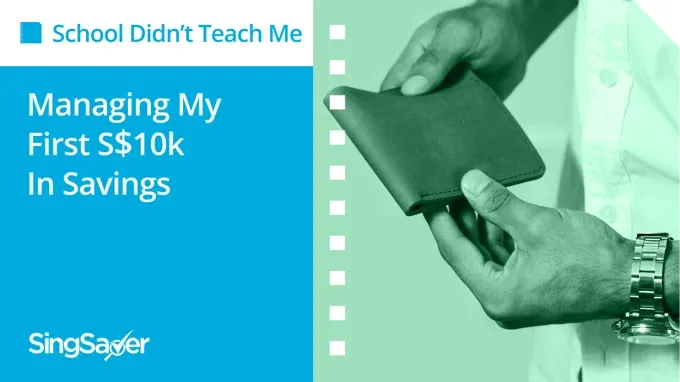How to Invest S$10,000 in Singapore | Short & Long Term Options
Updated: 11 Apr 2025
With $10,000, you have a wide range of investment opportunities. Here are some of the best ways to invest $10,000 in Singapore.
Written bySingSaver Team
Team

The information on this page is for educational and informational purposes only and should not be considered financial or investment advice. While we review and compare financial products to help you find the best options, we do not provide personalised recommendations or investment advisory services. Always do your own research or consult a licensed financial professional before making any financial decisions.
With $10,000, you have a wide range of investment opportunities. Here are some of the best ways to invest $10,000 in Singapore.
If you somehow have $10,000 to spare, it’s understandable if the question “what can I invest $10,000 in” is top of your mind. The good news, $10,000 is a lot of money – it opens up a range of possibilities. We'll explore some of them in this guide.
Note: For those who want their money to work for them without actively managing the investments themselves, a robo-advisor can be a good option in Singapore. These platforms typically charge a small annual fee to manage your investments, help you create a portfolio based on your financial goals and timeframe, and then manage it for you over time. Here are our picks for the best robo-advisors in Singapore.
1. Define your investment goals
Your ultimate goal matters significantly because it – and your timeframe for achieving it – should heavily influence how you decide how to invest $10k in Singapore.
Why is this important? Firstly, it depends on your investment timeline. If you need the money in five years or less (e.g., for a down payment on a flat, education expenses, or a wedding), it's generally advisable to avoid the stock market, which can be quite volatile in the short term.
Instead, the best way to invest 10k short-term is via lower-risk options that still provide reasonable returns. This also applies if you're setting aside this money for an emergency fund – you'll want it readily accessible, perhaps in a high-yield savings account.
>> Here are the best ways to invest money in 2025.
However, if you have a longer investment horizon, you'll likely want to allocate at least a portion of your money to investments with higher growth potential.
The other key reason for identifying your goal is that some investment schemes are specifically designed for particular objectives. For example, in Singapore, the Central Provident Fund (CPF) and the Supplementary Retirement Scheme (SRS) offer tax benefits for saving for retirement.
While these aren't accounts where you would directly invest your money, they are crucial components of long-term financial planning in Singapore and should be considered alongside other investment options. These schemes also have rules and restrictions on withdrawals before certain ages.
If you're unsure of your exact needs for this money, that's perfectly fine – we'll still provide suitable investment options below.
To summarise, here's how to think about your goals:
-
Short-term goals: These might include saving for a home, education, or a wedding. When investing for these goals, prioritise stability and accessibility.
-
Long-term goals: These often involve retirement planning or wealth accumulation. For these, you can generally afford to take on more investment risk for potentially higher returns.
Finally, it's essential to align your investment strategy with your risk appetite:
-
Conservative: Prioritising capital preservation with lower-risk investments.
-
Balanced: Seeking moderate growth with a mix of lower and higher-risk investments.
-
Aggressive: Aiming for high growth with a focus on higher-risk investments.
Understanding your goals, timeframe, and risk tolerance is paramount to making informed decisions about what to invest 10k in.
2. Picking the right investment account for you
As discussed, your investment goals will influence the type of account that best suits your needs.
Singapore’s retirement investment schemes
If your primary goal is long-term retirement planning, Singapore offers specific schemes designed to help you grow your nest egg. Let's delve into each of these.
CPF Investment Scheme (CPFIS)
The CPF Investment Scheme allows you to invest your Ordinary Account (OA) and Special Account (SA) savings in various approved investment products.
-
Eligibility: Most CPF members can participate, but there are certain age and savings requirements.
-
Benefits: It allows you to potentially grow your CPF savings at a higher rate than the CPF interest rates, but it's important to be aware of the risks involved.
-
Investment Choices: You can invest in products like unit trusts, insurance products, Singapore Government Securities, and shares.
-
Planning: CPFIS should be used as part of your overall retirement planning strategy, considering your risk tolerance and investment timeframe.
Supplementary Retirement Scheme (SRS)
The Supplementary Retirement Scheme (SRS) is a voluntary scheme to encourage individuals to save for retirement, in addition to their CPF savings.
-
Eligibility: Singapore Citizens, Permanent Residents, and foreigners can contribute to SRS.
-
Benefits: SRS contributions are eligible for tax relief, which can significantly reduce your income tax payable. The returns on SRS investments are also tax-free before withdrawal at or after the statutory retirement age.
-
Investment Choices: You can invest your SRS funds in a wide range of products, including stocks, bonds, unit trusts, and insurance products.
-
Planning: SRS is a powerful tool for tax optimisation and long-term retirement savings, but early withdrawals are subject to penalties, so it's important to plan carefully.
Both CPFIS and SRS offer valuable avenues for how to best invest 10k for retirement in Singapore. When deciding what to invest 10k in within these schemes, carefully consider your risk appetite and the specific rules governing withdrawals to ensure they align with your overall retirement goals.
>> Here are some investments you can make under the CPFIS.
Investing through brokerage platforms
For most investors looking for the best way to invest $10k for 1 year, that will involve using a brokerage account. These platforms provide the means to buy and sell various investment products. In Singapore, several online brokerage platforms are popular, offering access to both local and international markets. Examples include:
When choosing a brokerage account in Singapore, consider the following key factors:
-
Fees: Pay attention to commission fees, platform fees, and any other charges associated with trading. Different brokers have different fee structures, so compare carefully to find the most cost-effective option for your trading frequency and style.
-
Market access: Ensure the platform offers access to the markets and investment products you're interested in. Some brokers specialise in Singapore (SGX) stocks, while others provide broader access to global markets like the US, Hong Kong, and others.
-
User experience: Evaluate the platform's ease of use, trading tools, research resources, and customer support. A user-friendly platform can significantly enhance your investing experience.
>> These are our picks for the best brokerage accounts
Alternative investment options
Beyond retirement schemes and brokerage accounts, Singapore offers other avenues for how to best invest 10k.
A prominent alternative, particularly suitable for those seeking a hands-off approach, is robo-advisors. Platforms like Syfe, StashAway, and Endowus have gained popularity in Singapore. These robo-advisor platforms offer automated investment management, constructing and managing diversified portfolios based on your risk tolerance and financial goals. They often have lower minimum investment amounts compared to traditional wealth managers, making them accessible for a wider range of investors.
For those prioritising capital preservation and lower risk over potentially higher growth, options like high-yield savings accounts and fixed deposits available through Singaporean banks remain relevant. These are generally not considered investment accounts in the same vein as stocks or ETFs, but they offer a safe place to grow your $10,000 steadily.
When deciding what to invest 10k in, it's important to weigh these alternative account options alongside brokerage accounts and retirement schemes to find the best fit for your financial situation and objectives.
Diversify your portfolio, effortlessly
View our picks for the best brokerage accounts for Singapore stocks. Start your investment journey today.
3. What you should invest in
It's important to remember that an investment account is simply the platform; the crucial decision is what you'll actually invest in. When considering what to do with your $10,000 in Singapore, index funds and ETFs are often excellent starting points.
Index funds and ETFs offer diversification, which is key to managing risk. Instead of investing in a single company, you're investing in a basket of companies within a specific index, sector, or market. This helps to smooth out volatility. They also tend to have lower costs compared to actively managed funds, which can significantly improve your long-term returns.
For Singaporean investors, here are some relevant examples:
-
STI ETF: This ETF tracks the Straits Times Index (STI), providing exposure to the top 30 companies listed on the Singapore Exchange (SGX). It's a convenient way to invest in the overall performance of the Singaporean stock market.
-
S&P 500 ETFs (e.g., VOO, CSPX): These ETFs track the S&P 500 index, giving you access to the performance of 500 of the largest U.S. companies. They're a popular choice for diversifying into the U.S. market.
-
REIT ETFs: These ETFs invest in Real Estate Investment Trusts, which own and operate income-producing properties. They can be a source of passive income and offer exposure to the real estate sector.
You can typically invest in these ETFs and index funds through a brokerage account. As mentioned earlier, platforms like Tiger Brokers, Moomoo, and Interactive Brokers offer access to a wide range of investment options. Some robo-advisors in Singapore also include ETFs in their portfolios, providing a more automated approach to investment management.
For most investors, especially those new to investing, ETFs and index funds provide a simple, diversified, and cost-effective way to invest $10,000.
Relevant articles
18 Top Passive Income Ideas for 2025 and Their Earning Potential
Passive income isn’t just about earning money with minimal effort — it’s about creating sustainable revenue streams that align with your financial goals and lifestyle. Whether through investments, rental properties, or digital ventures, diversifying your income sources can help you build long-term wealth and financial security, all while letting your money work for you.
Stay ahead in everything finance
Subscribe to our newsletter and receive insightful articles, exclusive tips, and the latest financial news, delivered straight to your inbox.
About the author
SingSaver Team
At SingSaver, we make personal finance accessible with easy to understand personal finance reads, tools and money hacks that simplify all of life’s financial decisions for you.

